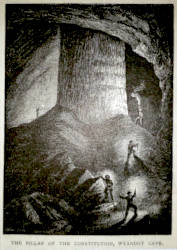Wyandotte Caves
Useful Information


| Location: | Crawford County, southern Indiana, U.S., near the village of Wyandotte. |
| Open: |
Memorial Day to Labor Day Fri, Sat, Sun 9-17. Little Wyandotte: 10, 11, 13, 14. Big Wyandotte: 11, 13. [2018] |
| Fee: |
Little Wyandotte: Adults USD 8, Children (6-11) USD 4. Big Wyandotte: Adults USD 18, Children (4-12) USD 9. [2018] |
| Classification: |
 Karst Cave
Mississippian limestones. Karst Cave
Mississippian limestones.
|
| Light: |
 Electric Light Electric Light
|
| Dimension: | L=40,000 m, T=12 °C. |
| Guided tours: |
Monument Mountain: D=90 min. Flowstone Falls: D=30 min. |
| Photography: | |
| Accessibility: | No, steps and narrow passages |
| Bibliography: |
John R Hill (1985):
The Geologic Story of Wyandotte Cave,
paperback, 10 pp illus. State of Indiana, Geological Survey.
|
| Address: |
Wyandotte Caves, P.O. Box 217, Marengo, IN 47140, Tel: +1-812-365-2705, Tel: +1-888-70-CAVES,
O’Bannon Woods State Park, 7234 Old Forest Road SW, Corydon, IN 47112, Tel: +1-812-738-8232. |
| As far as we know this information was accurate when it was published (see years in brackets), but may have changed since then. Please check rates and details directly with the companies in question if you need more recent info. |
|
History
| 1851 | Small Wyandotte discovered. |
| 1972 | designated a National Natural Landmark. |
| 24-MAY-2002 | caves under new management. |
| 2009 | cave closed to the public because of white nose syndrome. |
| 09-JUL-2016 | reopened to the public. |
| 2018 | lights of the cave repaired. |
Description
Wyandotte Caves are two different caves, both developed for visitors. The smaller Little Wyandotte has no long staircases and is thus suitable to visitors of all ages. It was discovered in 1851, and because of this recent discovery it is also called New Cave or Siberts Cave after its discoverer.
More impressive is the tour to Big Wyandotte aka Historic Cave, just 200 m away. The entrance of this cave was used as a shelter since prehistoric times.
In the Senate Chamber, 45 m long and 17 m wide, a stalagmite called Pillar of the Constitution is shown.
This is one of several "world’s largest stalagmite".
Sometimes it is described as the largest pillar stalagmite in a public cave.
But if this really is the largest or not, does not really matter: the 10 m high and 20 m wide stalagmite definitely is very impressive!
A highlight is the Rothrock’s Grand Cathedral, a huge chamber with the Monument Mountain, an enormous pile of rocks fallen from the ceiling of the cavern.
Another feature are rare
 helictites
in Crater Room.
helictites
in Crater Room.
Unlike the Little Wyandotte, this cave has lots of steps and visitors should wear appropriate shoes. It is home to the endangered Indiana bat (Myotis sodalis) which hibernates in the cave.
The caves were managed by the Indiana Department of Natural Resources (DNR) until 2001. From 2002 they were run by a private company under a concession agreement. Their first changes were the highest entrance fees for show caves at this time and a changed schedule. In 2008 the white nose syndrome, a bat disease which killed millions of bats, was spreading and the cave was thus closed to the public. After eight years it was reopened in summer 2016, now again managed by the Indiana Department of Natural Resources. The old domain was hijacked by the competitor Marengo Cave. However, the cave uses the page of the O’Bannon Woods State Park. Tours are guided by the staff of the State Park. Visitors have to do a decontamination when visiting the cave, as white nose syndrome is still a problem. This means actually to clean the equipment, espeially shoe soles, with a special anti fungizide solution.
- See also
 Caves With The Tallest Stalagmite
Caves With The Tallest Stalagmite Search DuckDuckGo for "Wyandotte Caves"
Search DuckDuckGo for "Wyandotte Caves" Google Earth Placemark
Google Earth Placemark Wyandotte Caves (visited: 20-DEC-2018)
Wyandotte Caves (visited: 20-DEC-2018) O’Bannon Woods State Park, official website of Wyandotte Caves (visited: 21-DEC-2018)
O’Bannon Woods State Park, official website of Wyandotte Caves (visited: 21-DEC-2018) Wyandotte Cave (visited: 20-DEC-2018)
Wyandotte Cave (visited: 20-DEC-2018) Wyandotte Cave Ancient Mine, Quarry or other Industry : The Megalithic Portal and Megalith Map: (visited: 13-OCT-2010)
Wyandotte Cave Ancient Mine, Quarry or other Industry : The Megalithic Portal and Megalith Map: (visited: 13-OCT-2010)
 Index
Index Topics
Topics Hierarchical
Hierarchical Countries
Countries Maps
Maps